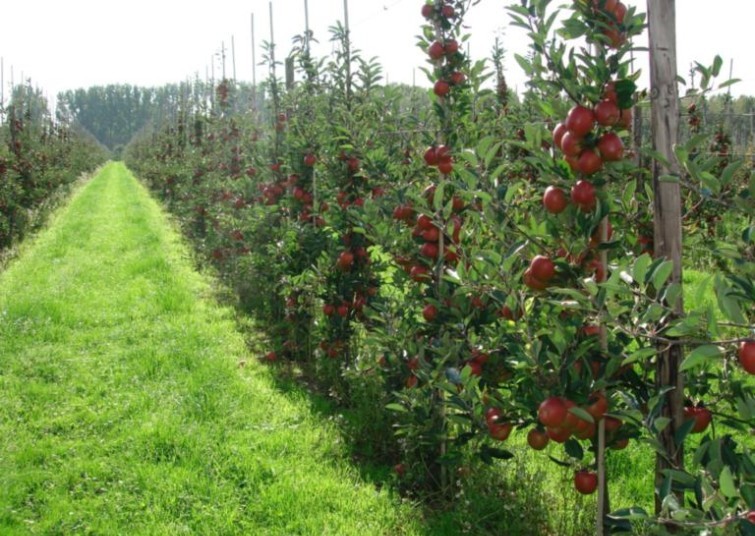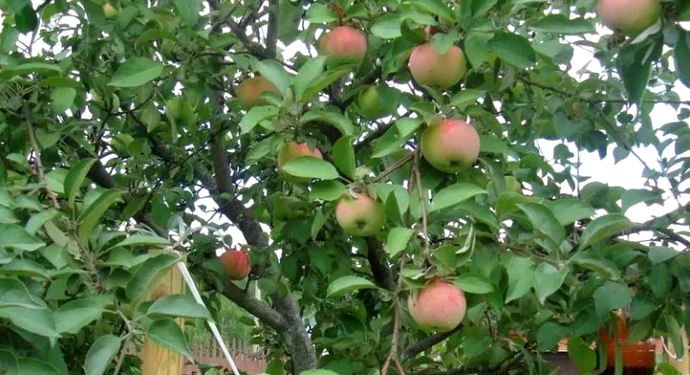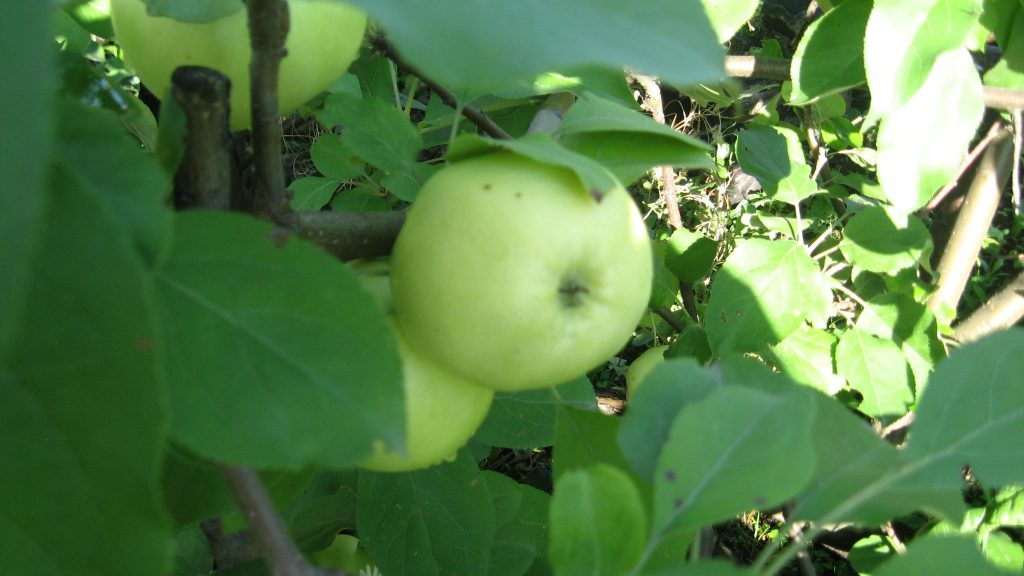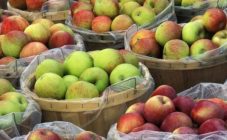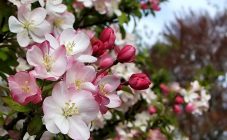Content:
There are usually two reasons for choosing a dwarf apple tree instead of the usual one for gardeners: saving space and the ability to provide stunted trees with the most careful care, because their crown does not exceed 3 m in height.
Features of dwarf and semi-dwarf apple trees
Dwarf and semi-dwarf apple trees are obtained by grafting varietal cuttings onto dwarf clonal rootstocks. In other words, each tree of this variety is not grown from seed, but obtained only by vegetative means. As a result, a young tree 100% retains all the characteristics inherent in the donor, except for one - growth.
The success of these varieties has many reasons, including:
- Early maturity. The first harvest from a seedling can be obtained in 2-3 years.
- Excellent consumer characteristics. Apples grow tasty, sweet and aromatic. If you do not know exactly which apple tree the fruits were taken from, then it is impossible to determine whether we are talking about a dwarf or an ordinary tree.
- Simplicity of care. The low crown makes it much easier to care for it. It is easy to carry out antiparasitic processing, pruning, harvesting with the help of a regular ladder. Semi-dwarfs are the tallest - their height can reach 3.5 m, while dwarf apple trees do not grow higher than 3 m, and often even lower.
- Beauty. Low-growing apple trees look attractive in any plantings. In the spring, during flowering and during the ripening period, apples are an extremely decorative sight.
- Compactness. This is true for the crown and root system. Most of the roots are located at a depth of only 70 cm. This is very valuable for areas with a high level of groundwater, as well as with heavy clay soils.
- Early fall of foliage. Usually, by mid-September, leaf fall is already completed, which greatly reduces the risk of damage to plantings by frost.
- Saving space. If in a standard apple orchard between individual trees it is necessary to maintain a distance of 4-5 m, then 1.5 m will be enough between dwarf trees, therefore, at a summer cottage of 6 acres of such weakly growing seedlings, you can place at least 25.
It is easy to distinguish seedlings from columnar seedlings by the root, which is not a rod-shaped, but fibrous. Dwarf rootstocks do not have thick roots at all. The buds of dwarf varieties, even at first glance, are much larger than ordinary ones. Intending to buy a dwarf or semi-dwarf seedling, you should be prepared for the fact that its price will be significantly higher than that of an ordinary one.
Not without disadvantages, which are important to know about:
- Short lifespan. An ordinary apple tree can bear fruit up to 60 years, but undersized varieties have a maximum fruiting duration of 20 years, and most of them only 13-15 years. However, you can see the positive side of this as well, since regular garden renewal allows you to appreciate many more newer varieties.
- Low frost resistance. It is due to the low occurrence of the root system.In severe frosts, the roots may freeze.
- Demanding on soil fertility. Top dressing for such varieties is necessary every year.
- Too profuse flowering. The apple tree strives to produce as much fruit as possible. To obtain a high quality harvest, up to a quarter of the inflorescences must be cut off. Those that are located close to the trunk are removed from them.
- Fragile branches. Often the weight of the fruit is so great that the branches break without additional supports.
- Low keeping quality. Tall varieties are distinguished by the highest keeping quality, it is difficult for dwarf varieties to compete with them.
Characteristics of varieties of dwarf and semi-dwarf apple trees
In domestic nurseries, you can find trees zoned for a specific region. The study of the description of varieties should not be neglected. Insufficient frost resistance will lead to the death of the seedling in the first winter. Drought resistance, disease resistance, pollination requirements are also important.
Dwarf apple varieties for the Moscow region
Cool summers and frosty winters are typical signs of the climate of the Moscow region. Not every variety can yield a crop and not die in such conditions. The following dwarf apple trees have proven themselves well:
- Melba Is a summer pollinated variety of yellow sweet apples, ripening at the end of July. The weight of the fruits ranges from 150-250 g. One tree for 3-4 years yields up to 40 kg. Keeping life: 3 months.
- Zhigulevskaya - a large-fruited autumn low-growing apple tree with golden-red apples weighing up to 350 g. Ripens at the end of September. Stored up to 3 months. Needs cross-pollination. One tree can produce up to 250 kg of fruit.
- Grushevka Moscow - one of the oldest winter varieties, ripening at the end of October. The fruits are quite small - about 100 g, but they are perfectly stored until summer. Differs in high frost resistance and fertility: up to 150 kg per tree.
Dwarf apple varieties for the Leningrad region
Swampy soils, severe frosts, high air humidity, proximity to the sea are all limiting factors suitable for a small number of varieties. Practice has shown that varieties take root well in the region:
- Antaeus - a late-ripening autumn apple tree with an average yield (up to 50 kg), as well as a high keeping quality of fruits (until May). Dark red apples weigh about 200 g, and the first fruiting occurs at 3 years. Weakly resistant to scab, but withstands frosts down to -30 ° C. Bears fruit actively in the period of 5-25 years.
- Delight - very sweet, medium-sized (up to 150 g) apples, beautiful raspberry color. The trees need cross-pollination and produce up to 80 kg of fruit. Drought and scab resistant winter-hardy variety. Already in mid-August, you can pick green apples with a pleasant sour taste and strong aroma, and the technical ripeness begins in mid-September.
- Ladoga - red sweet and sour apples weighing up to 150 g. Ripen in September. The tree is capable of producing up to 150 kg at a height of up to 3 m. Fruits are perfectly stored until March. The first crop is harvested in 5 years.
Low-growing apple trees for central Russia
A much wider varietal variety can be allowed here, because relatively mild winters allow not to fear the freezing of the gardens. Warm and long summers, a large amount of rainfall, fertile soils - all these are favorable factors suitable for growing apple trees in the best possible way.
The most positive reviews of gardeners for the following varieties:
- Wonderful - a dwarf apple tree with the most compact crown in the range of 1.6-2 m. The falling sprawling branches hardly hold green apples weighing up to 210 g. Productivity - up to 80 kg. Fruiting for 3-4 years. Ripens at the end of August. Keeping quality - until October.
- Snowdrop - a very undersized small apple tree up to 1.6 m high. Fruiting already for 3 years, it is very resistant to severe frosts and drought. The weight of apples is up to 170 g, and the yield is up to 120 kg per tree. Ripens in early September. Keeping life is 4 months.
- Imant - differs in late ripening (end of October) and high weight of dark red fruits with a pronounced waxy bloom, reaching 250 g or more. Scab-resistant variety, retains well until May. Resistant to frost.
The best varieties of dwarf apple trees for the Urals
Serious temperature changes from hot summers to frosty winters require resistance to freezing and drought from the varieties of fruit trees cultivated in the Urals. Such varieties of apple trees can fully boast of this:
- Souvenir Altai - reaches no more than 3 m in height, produces small red apples weighing up to 120 g. Ripens in late summer. High productivity is organically complemented by scab resistance, as well as self-fertility. The tree does not need neighbors in order to consistently give a high yield from year to year.
- Folding - an early summer variety of very light white-green apples, competing in popularity with White Naliv. The average weight of the fruits is 150 g, the harvest is harvested in the first half of August. Fruiting begins at the 4th year, and the growth with each subsequent year is several tens of kilograms, reaching 200 kg per tree.
- Bayan - plentifully fruiting variety. Apples weighing up to 150 g, yellow-green with a blush, ripen in early autumn with the appearance of a purple hue on the skin. The tree tolerates frosts down to -35 ° С. Differs in self-fertility, therefore it is suitable for single planting. Fruiting occurs at 4 years.
Everything you need to know about planting and caring for dwarf apple trees
It is very important to choose the right seedling before purchasing. Since it is quite difficult to vaccinate on your own, it is much more profitable to purchase ready-made grafted plants in nurseries. In this case, you need to know the signs of a high-quality scion:
- Between the stem and the root collar there is a clearly visible protrusion indicating the grafting site.
- A 2-year-old seedling should have 4 developed branches (the wild has many short branches without buds).
- The height of the tree is up to 0.5 m.
- The roots are fibrous in shape (in the wild - the taproot).
The optimal time for planting is spring, as soon as the soil thaws, or autumn (first decade of September). The place on the site is chosen as illuminated as possible, or with partial shade. The depth of the groundwater is ideally 1.5 m. The soil for planting is prepared in advance, enriching it with organic fertilizers, as well as digging up and achieving a homogeneous loose structure.
Pegs are placed at the bottom of the planting pit or trench for tying the seedlings, and only after that, a seedling is placed on a small mound of soil with fertilizers, carefully spreading its roots. Dumping the soil is carried out in stages, abundantly pouring water on each layer. After filling the hole, the scion point should be at least 3 cm above the ground level.
A circle with a diameter of about 50 cm is trampled around the trunk. Its edge is formed with a roller 15 cm high. This will facilitate the irrigation process, since it will not allow water to spread past the roots. Next, the top of the seedling is tied to a support peg, and the ground around is sprinkled with a layer of mulch made from sawdust, chopped grass, sunflower husks, etc.
Care
The main care for apple trees is to protect them from pests. Scab is the most common fungal disease for which trees are treated with fungicides. But in addition to this, apple trees are attacked by all kinds of insect pests, from which they are protected by spraying with special insecticides, as well as hanging traps, and carefully removing fallen leaves.
Top dressing is performed annually. Mullein solution is ideal, since you can simply water the planting with it several times per season.
Crown-forming pruning is performed from the first year. However, it is performed in the spring. The step-by-step manual is pretty simple. After the first year, the seedling is shortened to 50 cm. After another year, its 4-5 heels are shortened to 20 cm each. After that, every year the growing branches are shortened in the same way. As a result, a close to spherical crown is formed, which is optimal for most dwarf varieties.
In addition to forming, sanitary pruning is also carried out. It removes broken branches as well as malformed ones. In the spring, it is necessary to carefully inspect the crown and remove all frozen and dried out areas. Moreover, it is important to pay special attention to dry knots, because various woodworms often become the cause of their death.
Experienced gardening tips
The first rule of a gardener in caring for any variety of apple trees is not to leave the tree without care. It is not enough just to plant. The lack of pruning, annual feeding, treatment from pests is almost guaranteed to lead to the death of the tree, or the lack of harvest on it.
Given that many high-yield varieties require the presence of other apple trees on the site, it is best to take care of this right away, taking it as a guide to action. Several seedlings are selected at once for planting, focusing on their adaptability to the climatic features of the region.
